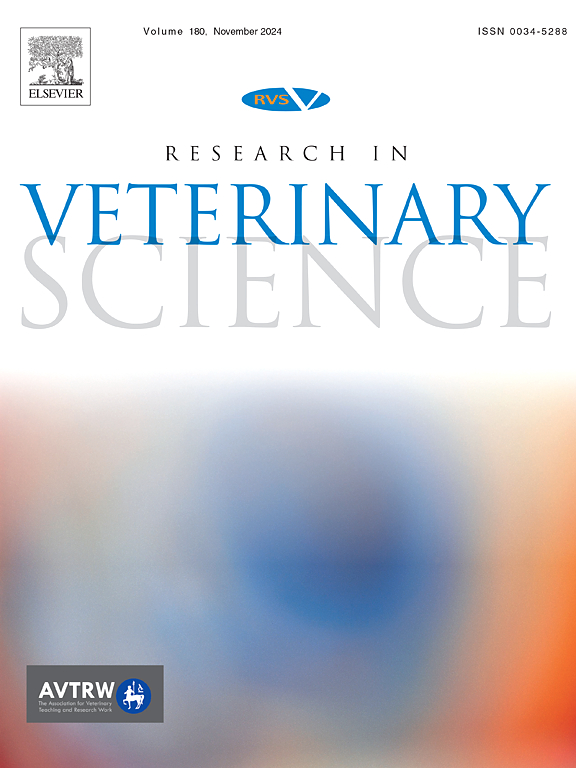A sensitive immunoassay for the quantitation of Pig-MAP in pig saliva samples
IF 2.2
3区 农林科学
Q1 VETERINARY SCIENCES
引用次数: 0
Abstract
The purpose of the study is to develop a sensitive assay for the proper quantification of the acute phase protein Pig-MAP in pig saliva samples. A time-resolved immunofluorometric assay (TR-IFMA) was developed using two pig-MAP-specific monoclonal antibodies. The limit of detection of the assay was 4 ng/mL, enough to measure pig-MAP concentration in saliva. Precision was evaluated for saliva samples of low, medium and high concentration, with inter assay CV of 4–14 % and inter-assay CV of 8–20 %. The assay kept linearity under dilution and a method comparison study performed with serum samples showed good correlation with ELISA. Median Pig-MAP concentration in saliva from healthy animals was 19 ng/mL whereas in pigs with different inflammatory conditions was 11 times higher. In the same animals median pig-MAP serum concentrations were 0.72 mg/mL in the healthy group and 4.61 in the diseased group. The Spearman coefficient of correlation between Pig-MAP concentration in serum and saliva was of 0.72. A correlation was also observed between the salivary concentration of pig-MAP and other two acute phase proteins such as haptoglobin (r = 0.62) or C-reactive protein (r = 0.65). The concentration of Pig-MAP in saliva of pigs with severe respiratory disease decreased significantly from a median value of 128 ng/mL at the time of disease detection to 8 ng/mL after 1 day of antibiotic therapy. Studies performed show that pig-MAP is present in saliva and this specimen may be an alternative to serum for pig-MAP quantification.
用于定量检测猪唾液样本中的 Pig-MAP 的灵敏免疫分析法。
本研究的目的是开发一种灵敏的检测方法,用于适当量化猪唾液样本中的急性期蛋白 Pig-MAP。研究人员使用两种猪-MAP 特异性单克隆抗体开发了一种时间分辨免疫荧光测定法(TR-IFMA)。该测定的检测限为 4 纳克/毫升,足以测量唾液中猪-MAP 的浓度。对低浓度、中等浓度和高浓度的唾液样本进行了精密度评估,测定间 CV 为 4-14 %,测定间 CV 为 8-20 %。该检测方法在稀释情况下保持线性,与血清样本进行的方法比较研究显示,该方法与 ELISA 有很好的相关性。健康动物唾液中猪-MAP 的中位浓度为 19 纳克/毫升,而在患有不同炎症的猪体内,猪-MAP 的中位浓度要高出 11 倍。在相同的动物中,健康组的猪-MAP 血清浓度中位数为 0.72 毫克/毫升,患病组为 4.61 毫克/毫升。血清和唾液中猪-MAP 浓度的斯皮尔曼相关系数为 0.72。唾液中的 Pig-MAP 浓度与其他两种急性期蛋白(如血红蛋白(r = 0.62)或 C 反应蛋白(r = 0.65))之间也存在相关性。患有严重呼吸道疾病的猪唾液中的 Pig-MAP 浓度从发现疾病时的中位值 128 纳克/毫升显著下降到抗生素治疗 1 天后的 8 纳克/毫升。研究表明,猪唾液中含有猪-MAP,这种样本可以替代血清进行猪-MAP 定量。
本文章由计算机程序翻译,如有差异,请以英文原文为准。
求助全文
约1分钟内获得全文
求助全文
来源期刊

Research in veterinary science
农林科学-兽医学
CiteScore
4.40
自引率
4.20%
发文量
312
审稿时长
75 days
期刊介绍:
Research in Veterinary Science is an International multi-disciplinary journal publishing original articles, reviews and short communications of a high scientific and ethical standard in all aspects of veterinary and biomedical research.
The primary aim of the journal is to inform veterinary and biomedical scientists of significant advances in veterinary and related research through prompt publication and dissemination. Secondly, the journal aims to provide a general multi-disciplinary forum for discussion and debate of news and issues concerning veterinary science. Thirdly, to promote the dissemination of knowledge to a broader range of professions, globally.
High quality papers on all species of animals are considered, particularly those considered to be of high scientific importance and originality, and with interdisciplinary interest. The journal encourages papers providing results that have clear implications for understanding disease pathogenesis and for the development of control measures or treatments, as well as those dealing with a comparative biomedical approach, which represents a substantial improvement to animal and human health.
Studies without a robust scientific hypothesis or that are preliminary, or of weak originality, as well as negative results, are not appropriate for the journal. Furthermore, observational approaches, case studies or field reports lacking an advancement in general knowledge do not fall within the scope of the journal.
 求助内容:
求助内容: 应助结果提醒方式:
应助结果提醒方式:


